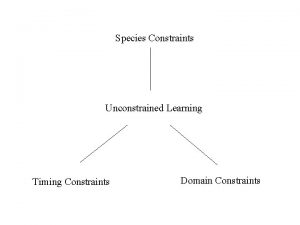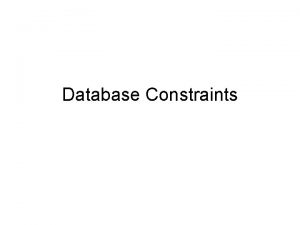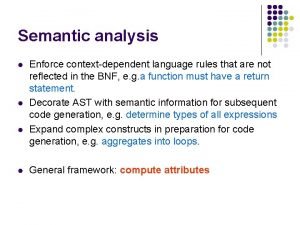What Are Constraints Constraints enforce rules at the










- Slides: 10

What Are Constraints? • Constraints enforce rules at the table level. • Constraints prevent the deletion of a table if there are dependencies. • The following constraint types are valid in Oracle: – NOT NULL – UNIQUE – PRIMARY KEY – FOREIGN KEY – CHECK 11 -1 Copyright Ó Oracle Corporation, 1998. All rights reserved.

Constraint Guidelines • Name a constraint or the Oracle Server will generate a name by using the SYS_Cn format. • Create a constraint: – At the same time as the table is created – After the table has been created • Define a constraint at the column or table level. • View a constraint in the data dictionary. 11 -2 Copyright Ó Oracle Corporation, 1998. All rights reserved.

The NOT NULL Constraint Defined at the column level SQL> CREATE TABLE 2 empno 3 ename 4 job 5 mgr 6 hiredate 7 sal 8 comm 9 deptno 11 -3 emp( NUMBER(4), VARCHAR 2(10) NOT NULL, VARCHAR 2(9), NUMBER(4), DATE, NUMBER(7, 2), NUMBER(7, 2) NOT NULL); Copyright Ó Oracle Corporation, 1998. All rights reserved.

The PRIMARY KEY Constraint Defined at either the table level or the column level SQL> CREATE TABLE 2 deptno 3 dname 4 loc 5 CONSTRAINT 6 CONSTRAINT 11 -4 dept( NUMBER(2), VARCHAR 2(14), VARCHAR 2(13), dept_dname_uk UNIQUE (dname), dept_deptno_pk PRIMARY KEY(deptno)); Copyright Ó Oracle Corporation, 1998. All rights reserved.

The FOREIGN KEY Constraint Defined at either the table level or the column level SQL> CREATE TABLE emp( 2 empno NUMBER(4), 3 ename VARCHAR 2(10) NOT NULL, 4 job VARCHAR 2(9), 5 mgr NUMBER(4), 6 hiredate DATE, 7 sal NUMBER(7, 2), 8 comm NUMBER(7, 2), 9 deptno NUMBER(7, 2) NOT NULL, 10 CONSTRAINT emp_deptno_fk FOREIGN KEY (deptno) 11 REFERENCES dept (deptno)); 11 -5 Copyright Ó Oracle Corporation, 1998. All rights reserved.

The CHECK Constraint • Defines a condition that each row must satisfy • Expressions that are not allowed: – References to CURRVAL, NEXTVAL, LEVEL, and ROWNUM pseudocolumns – Calls to SYSDATE, UID, USER, and USERENV functions – Queries that refer to other values in other rows. . . , deptno NUMBER(2), CONSTRAINT emp_deptno_ck CHECK (DEPTNO BETWEEN 10 AND 99), . . . 11 -6 Copyright Ó Oracle Corporation, 1998. All rights reserved.

Adding a Constraint Add a FOREIGN KEY constraint to the EMP table indicating that a manager must already exist as a valid employee in the EMP table. SQL> ALTER TABLE emp 2 ADD CONSTRAINT emp_mgr_fk 3 FOREIGN KEY(mgr) REFERENCES emp(empno); Table altered. 11 -7 Copyright Ó Oracle Corporation, 1998. All rights reserved.

Dropping a Constraint • Remove the manager constraint from the EMP table. SQL> ALTER TABLE 2 DROP CONSTRAINT Table altered. emp_mgr_fk; • Remove the PRIMARY KEY constraint on the DEPT table and drop the associated FOREIGN KEY constraint on the EMP. DEPTNO column. SQL> ALTER TABLE dept 2 DROP PRIMARY KEY CASCADE; Table altered. 11 -8 Copyright Ó Oracle Corporation, 1998. All rights reserved.

Disabling Constraints • Execute the DISABLE clause of the ALTER TABLE statement to deactivate an integrity constraint. • Apply the CASCADE option to disable dependent integrity constraints. SQL> ALTER TABLE 2 DISABLE CONSTRAINT Table altered. 11 -9 emp_empno_pk CASCADE; Copyright Ó Oracle Corporation, 1998. All rights reserved.

Enabling Constraints • Activate an integrity constraint currently disabled in the table definition by using the ENABLE clause. SQL> ALTER TABLE 2 ENABLE CONSTRAINT Table altered. emp_empno_pk; • A UNIQUE or PRIMARY KEY index is automatically created if you enable a UNIQUE key or PRIMARY KEY constraint. 11 -10 Copyright Ó Oracle Corporation, 1998. All rights reserved.
 Enforce picture
Enforce picture Mikael ferm
Mikael ferm Enforce
Enforce How did louis xiv gain, consolidate, and maintain power?
How did louis xiv gain, consolidate, and maintain power? Wanted: a just right government
Wanted: a just right government All groups create norms to enforce their cultural values.
All groups create norms to enforce their cultural values. Hát lên người ơi
Hát lên người ơi điện thế nghỉ
điện thế nghỉ Một số thể thơ truyền thống
Một số thể thơ truyền thống Trời xanh đây là của chúng ta thể thơ
Trời xanh đây là của chúng ta thể thơ Bảng số nguyên tố lớn hơn 1000
Bảng số nguyên tố lớn hơn 1000



















